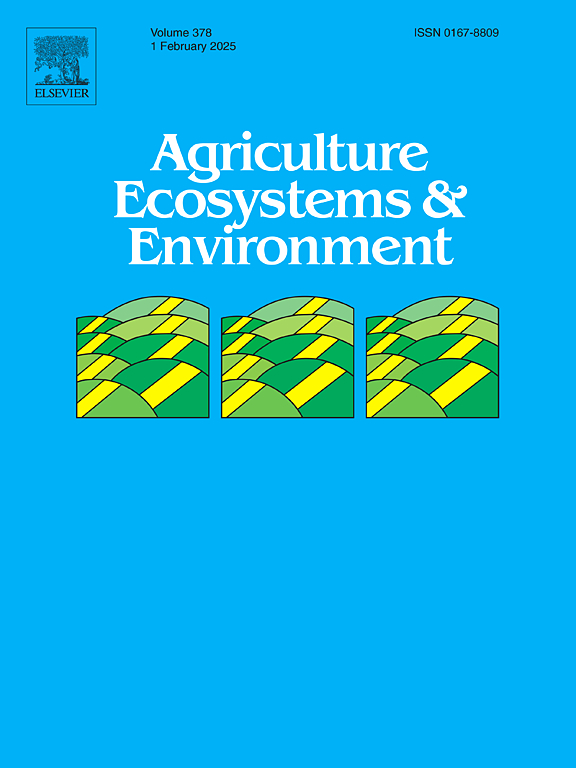百慕大草(Cynodon dactylon, L.)的牧草收割计划和氮肥对农艺和环境的影响
IF 6.4
1区 农林科学
Q1 AGRICULTURE, MULTIDISCIPLINARY
引用次数: 0
摘要
百慕大草(Cynodon dactylon, L.)因其营养价值和在各种农业生态条件下的生长能力而被广泛用作反刍动物饲料。针对美国东南部的气候条件,以前对百慕大草的研究建议采用 Tifton 85 栽培品种生产牧草,并建议每月割草一次。尽管众所周知百慕大草栽培品种对氮(N)肥有积极的反应,但人们对牧草收割和氮肥施用量之间的相互影响还不甚了解。因此,没有足够的指导来制定适当的收割计划和施肥管理,以优化百慕大草的牧草产量。因此,本研究旨在阐明生物量切割事件和氮肥施用率对牧草质量和数量以及氮足迹的相互影响。研究使用了三种氮肥施用率(即高 = 504 kg N ha-1、中 = 336 kg N ha-1 和低 = 168 kg N ha-1)下百慕大草 Tifton 85 饲料生产的实验数据,以校准和验证根区水质模型 2(RZWQM2)的生物量重量和生物量氮含量。针对每种氮肥施用率,对四种生物量削减方案进行了多年模拟,以研究收获期和氮肥施用率对生物量重量、生物量氮含量、氮利用效率(NUE)和氮浸出的共同影响。结果表明,在高、中氮肥施用率下,生物量切割方案对生物量重量和生物量氮含量的影响具有统计学意义。生物量切割和氮肥的相互作用对牧草质量和数量以及氮足迹的影响各不相同。除生物量重量外,低氮肥量对其他方面的影响在统计学上并不显著。与高氮肥相比,中氮肥和低氮肥的氮利用效率值都更高,而高氮肥的氮浸出率相对较高。这项研究的结果可用于指导百慕大草的割草和施肥方案,以实现牧草产量目标,同时了解氮沥滤和低氮利用效率对环境的潜在影响。本文章由计算机程序翻译,如有差异,请以英文原文为准。
Agronomic and environmental effects of forage-cutting schedule and nitrogen fertilization for bermudagrass (Cynodon dactylon, L.)
Bermudagrass (Cynodon dactylon, L.) is widely used as a forage in ruminant diets owing to its nutritional value and its capacity to grow under various agroecological conditions. For the southeastern United States climate conditions, previous research on bermudagrass recommended the cultivar Tifton 85 for forage production and a monthly frequency for forage-cutting. Even though bermudagrass cultivars are known to positively respond to nitrogen (N) fertilization, the interplay of the forage-cutting and N fertilization rates is not well understood. As a result, there is not sufficient guidance for adequate harvesting schedules and fertilization management to optimize bermudagrass forage production. Hence, this study aims to clarify the interplay of biomass-cutting events and N fertilization rates on forage quality and quantity, and N footprint. The study used experimental data of bermudagrass Tifton 85 forage production under three N fertilization rates (i.e., high = 504 kg N ha−1, medium = 336 kg N ha−1, and low = 168 kg N ha−1), to calibrate and validate Root Zone Water Quality Model 2 (RZWQM2) for biomass weight and biomass N content. For each N fertilization rate, multiyear simulations of four biomass-cutting scenarios were used to investigate the joint effects of harvesting schedules and N fertilization rates on biomass weight, biomass N content, N use efficiency (NUE), and N leaching. Results show statistically significant effects of the biomass-cutting scenarios on biomass weight and biomass N content for both high and medium N fertilization rates. The interplay of biomass-cutting and N fertilization reflected differently on forage quality and quantity, and N footprint. The low N fertilization did not show any statistically significant effect except for the biomass weight. NUE values were higher with both medium and low N fertilization rates compared to the high N fertilization which showed a relatively high N leaching. The outcomes of this study can be used to inform bermudagrass cutting and fertilization options to achieve forage yield goals with an understanding of the potential environmental consequence of N leaching and low NUE.
求助全文
通过发布文献求助,成功后即可免费获取论文全文。
去求助
来源期刊

Agriculture, Ecosystems & Environment
环境科学-环境科学
CiteScore
11.70
自引率
9.10%
发文量
392
审稿时长
26 days
期刊介绍:
Agriculture, Ecosystems and Environment publishes scientific articles dealing with the interface between agroecosystems and the natural environment, specifically how agriculture influences the environment and how changes in that environment impact agroecosystems. Preference is given to papers from experimental and observational research at the field, system or landscape level, from studies that enhance our understanding of processes using data-based biophysical modelling, and papers that bridge scientific disciplines and integrate knowledge. All papers should be placed in an international or wide comparative context.
 求助内容:
求助内容: 应助结果提醒方式:
应助结果提醒方式:


